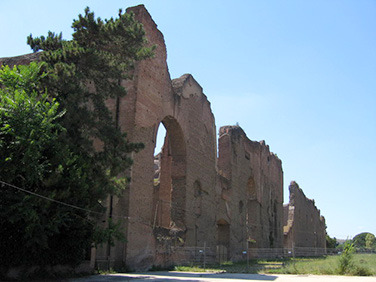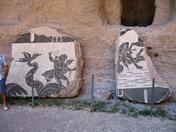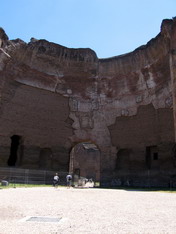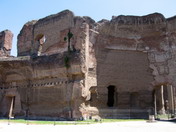Caracalla - Bathhouse in Rome
According to an old saying in Rome, a fool was: "He who can not read or swim."
To bathe (and swim) was in other words, something you took very seriously in ancient Rome.
Terme di Caracalla was one of the biggest bathhouses in the ancient Rome. You can still visit the ruins and marvel at how great it must have been once upon a time. Baths were only permitted for men, and it also was a gathering place where there was room for both studies and philosophical discussions and of physical exercise and relaxing temperate bath.
(Click the photos from Rome of Caracalla for larger versions)
Today, most of Caracalla is lost and the plants have begun to take over. Half the surface of the bath, the part previously used for gardens has turned into a park. Here they nowaday organizeconcerts.
The hall where they bathed cold bath (frigidarium) had no roof instead, there was room for spectators who could look down on bathers.
Map of Caracalla »
Fact about Caracalla
Terme di Caracalla as it is called in Italy, was neither the first nor the largest bathhouse but is one of the best preserved which even today can help you get an overall picture of how a bathhouse could look like in ancient Rome.
Caracalla was built in 217 AD and according to some calculations. At that time there was 11 public baths, 926 private ones and approximately 2,000 fountains.
14 aqueducts were required to supply them with all the water. Aqua Marcia was the aqueduct which supplied the Caracalla with water.
Marcus Aurelius Bassi Julian was born 186 AD and was a Gallic. He dressed accordingly to that in a long robe with a hood which was named cara calla.
He therefore got the nickname Caracalla of the people. He later became emperor and one of his achievements was to build the giant public terms (bathhouses). He unfortunately suffered from a disease that changed him. He was previously a kind and reasonable person but it ended up with him murdering his brother Geta whom he shared power with. To his defense it can be said that Geta apparently should have been both rude, deceitful and fraudulent. Marcus died in 217, 31 years old in a campaign against the Parthians.
The public bathhouses that Marcus built in Rome (Caracalla was one of them) had room for approximately 1,600 bathers and had dimensions of 337 x 338 meters. This corresponds to an area of 113,906 square meters. It also emerged during excavations that there were about 5 km with aisles during baths with room for plumbings, ventilation and drainage.
Diocletian's terms was the largest in Rome and had room for approximately 2,000 bathers. Plenty of room in the pool in other words!
The interior of the bathhouse was well designed. In the middle, there were large cold bath (frigidarium) with open roof and space for spectators. On each side there were dressing rooms and rooms to rub in oil for the one that was going to workout and chat room for anyone who wanted to discuss.
Inside the cold bath was a huge room (tepidarium) equipped with a roof which was supported by the cross vaults and colossal pillars. The room was one of the more lavish and had four basins with warm water and a shower (lavatio) in the middle.
Another step deeper into the bath house it was a large circular hall (calidarium) with 50 meters in diameter. It was supported by 12 granite columns and roof consisting of a dome was supported by eight pillars.
The walls were related to the heat spread and Hall had seven vats of hot baths.
Other rooms in the bathhouse were for physical exercises, sweat etc.. but there was also a library. In the outer parts of the bathhouse, there were landscaped parks and gardens and more libraries. Here the men of ROme walked, discussed and philosophized.
In 600's the use of the bathhouses endern and in 900's, they were transformed into ruins during saraceneras ravages. Later, during the Middle Ages, they were used for storage of marble and bricks. At later excavations have also found many now famous works of art that spread to various museums.
In the book Emperors Rome can find more facts about baths but also a couple of pictures where you have built models of how it once looked.
Have you decided to go to Rome, it may be a good idea to visit our Guide to Rome and perhaps learn a few phrases in Italian






